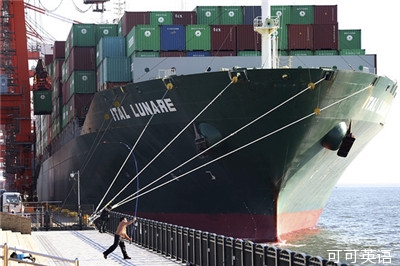
If there was one thing that Japan could always count on to drive its economy after World War II, it was exports. But just as the world's third-largest economy starts showing signs of life again, it appears outbound shipments may be taking a back seat.
二戰(zhàn)以來日本一直依賴出口推動經(jīng)濟增長,但目前在這個全球第三大經(jīng)濟體剛剛開始顯現(xiàn)復蘇跡象的關頭,出口的推動作用似乎要落后了。
Exports grew just 1.7% in the fourth quarter of 2013 after a 2.7% annualized fall in the third quarter, gross domestic product data released Monday showed.
周一公布的國內(nèi)生產(chǎn)總值(GDP)數(shù)據(jù)顯示,2013年第四季度日本出口僅增長了1.7%,第三季度下降了2.7%。
While this was a rebound, it was hardly a strong one for a component of the GDP that frequently racks up double-digit percentage gains, especially when the sharply weaker yen, which is supposed to make Japanese exports more competitive overseas, is taken into consideration.
雖然第四季度出口實現(xiàn)了反彈,但作為GDP中經(jīng)常以兩位數(shù)速度增長的組成部分,這一增速并不算強勁,特別是考慮到這一增速是在日圓大幅貶值的情況下取得的。日圓貶值令日本出口到海外的商品更具競爭力。
'The expected recovery in exports didn't materialize,' said a senior government official.
一名高級政府官員稱,出口復蘇沒有達到預期。
In the fourth quarter, the sluggish exports kept overall growth at 1.0%, much below the over 5% growth Japan needed to achieve 2.6% growth projected for the fiscal year ending March.
第四季度出口遲滯令整體經(jīng)濟增速保持在1.0%,而截至今年3月的財年若要實現(xiàn)2.6%的增長目標,則第四季度的經(jīng)濟增速需要超過5%。
Domestic demand has been strong recently, but that isn't seen as enough to put Japan on a long-term growth path of 2% to 3% called for by Prime Minister Shinzo Abe, officials say.
官員稱,最近日本國內(nèi)需求強勁,但還不足以推動日本經(jīng)濟實現(xiàn)首相安倍晉三(Shinzo Abe)預計的2%-3%的長期增速。
And lifting exports won't be easy either, with much of the nation's manufacturing sector having moved overseas over the past few years.
而由于過去幾年日本多數(shù)制造企業(yè)陸續(xù)向海外搬遷,增加出口也不是一件容易的事。
Take electronics, for instance. Japanese TVs, refrigerators, air conditioners and computers are now mostly assembled in China. So it would stand to reason that even if the global economy continues to recover it wouldn't translate into increased shipments of domestically produced electronics.
以電子產(chǎn)品為例,目前日本的電視機、冰箱、空調(diào)和電腦多數(shù)都在中國組裝。因此即便全球經(jīng)濟繼續(xù)復蘇,日本國內(nèi)生產(chǎn)的電子產(chǎn)品的發(fā)貨量也不會增加。
Auto makers have also increasingly been moving production overseas.
汽車制造商也一直在將生產(chǎn)轉移到海外。
In November, Nissan Motor Co. opened its third plant in Mexico, a move that is expected to reduce the firm's auto exports from Japan. Honda Motor Co. will also start producing Fit-brand cars in Mexico, instead of exporting the subcompact model from Japan, beginning in February.
去年11月日產(chǎn)汽車(Nissan Motor Co., 7201.TO)在墨西哥開設第三家工廠,此舉預計將減少日產(chǎn)汽車從日本出口的汽車數(shù)量。本田汽車(Honda Motor Co., 7267.TO) 2月也將開始在墨西哥生產(chǎn)Fit品牌汽車,而不再從日本出口這款小型車。
A 7% fall in auto exports to the U.S. in December is likely to be a harbinger for what's to come, industry officials say.
行業(yè)高管稱,去年12月日本對美國汽車出口減少了7%,這可能是一種先兆。
With the trend of moving production abroad ongoing even as signs of an economic recovery become more apparent, Mr. Abe has only a short window to stop the trend.
即便經(jīng)濟復蘇的跡象愈發(fā)明顯,但日本企業(yè)將生產(chǎn)轉移到海外的趨勢仍在繼續(xù),安倍只有很短的時間來阻止這種趨勢。
At the top of his list of solutions is reducing Japan's corporate tax rates. At 38%, Japan's corporate tax has created a significant obstacle for firms looking to do business in Japan, and is expected to be discussed intensively this year, another Japanese official said.
第一種解決辦法是降低日本企業(yè)的稅率。另外一名日本官員稱,日本公司稅高達38%,成為企業(yè)在日本經(jīng)商的巨大障礙,預計這個問題今年將會被密集地討論。
Another possible solution would be if the faltering U.S.-led Trans-Pacific Partnership gets back on track and Japan gets on board, the official added.
這位官員補充稱,另外一個可能的解決辦法是,重啟美國主導的跨太平洋伙伴關系協(xié)定(Trans-Pacific Partnership, 簡稱TPP)談判,而日本加入該協(xié)定。
Analysts say the TPP would help remove trade barriers to some of the rapidly growing markets in emerging Asia, especially in the field of public works projects, which are currently restricted to local companies.
分析師稱,TPP將有助于消除一些快速增長的新興亞洲經(jīng)濟體市場的貿(mào)易壁壘,特別是公共工程項目方面的貿(mào)易壁壘,這些項目目前僅允許本地公司參與建設。












